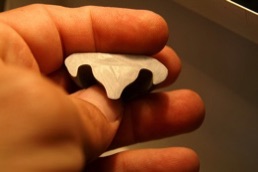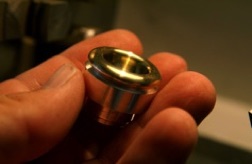Trumpet Mouthpiece Copies


All copy work is without a gaurantee except that it is a good faith effort to copy and existing mouthpiece.
The process that I use for making a mouthpiece copy is fairly simple but takes skill and practice. An impression of the mouthpiece needs to be made out of epoxy and then split in half. The 3D half-round settles into the new cup and rim and when the impression touches all the way from the outside of the rim to throat entrance the copy is done. This method is very acurate. You can see a gap of only one thousadth of an inch. Essentially, the process is to cut away the brass where ever the impression and brass are touching. Do this over and over being very careful at the end. Usually there is a cutter that gets it about 80 to 90 percent there, and the hand cutting finishes things.
Ask pretty much anybody and they will tell you that copying mouthpieces is problematic. There are a few issues to be aware of.
First, copying rims is pretty easy, but the players lips are incredibly sensitive. The issues of getting the contour right are the same as when I make any rim. The buffing process is where it can all go bad. The impression process is really accurate, and you can see exactly what kind of match you have. I just have to concentrate and it fairly easy to get right all through the buffing process.
I have gotten quite good at this
in the last 40 years. Having said that it
should be noted that some pieces pose
particular problem. Most mouthpieces to
some degree are not perfectly concentric.
(and some are WAAAAY off)
That means that one side of the inner
edge "bite" will be softer or sharper than
the opposite side. It sounds like a bad
thing, but lots of players will always turn
the piece so that the sharper edge is at
the bottom or top lip and then that
mouthpiece is MAGIC. Well, that is hard to
copy. When you make the impression, and
split it in half, you only get two points of
reference.
The copy made will be quite close to the
original but wont have the non-concentric
magic.
Players sometimes feel the new smooth finish on the copy as being “different” than the original. That can be frustrating. Also, usually when you do a copy, it’s because someone wants to experiment with throat size, or mass of the blank, or backbores, or something else. When those things change, some people swear they perceive the rim or cup as being “different”. It’s pretty psychological making a copy.
Some people say that “you cant copy a backbore” but thats not really true. To copy a backbore you can do it a couple of ways. The good way is to reverse engineer the backbore. I have come up with a simple and fast and accurate way to reverse engineer a backbore reamer. I have done it many times, but it is a little tedious and requires making a tool steel mandrel the exact shape and size of the backbore and then heat treating it to harden it, and then grinding it to a half round profile (called a "single flute reamer"). Doing this would cost at least $300 and honestly nobody has ever asked me to do it. By the way, making these things is kind of a "right of passage" into the mouthpiece making trade. Gerald Endsley told me when I was 19 that making one would give me skills around the machine and he was very correct. Great guy.
The Less good way, but pretty valid, (and fast and easy) is to take all your collection of backbore reamers, and see how far they go into a backbore. Mark it and run the smallest tool in to the mark. Then do that with the next bigger backbore reamer, and repeat till you have gone thru the reamers for smallest to biggest. The good thing with screw backbores is that becomes less of an issue when doing a copy.